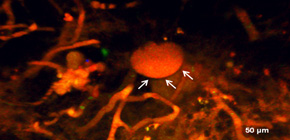
Olfactory Plays a Key Role in Spatiotemporal Pathogenesis of Cerebral Malaria
Expectations for early diagnosis and new treatment modalities
Summary
A special and truly overlooked spot, vulnerable to Plasmodium parasites during experimental cerebral malaria, has been discovered using highly sensitive ultra-high field MRI and multi-photon live imaging by the Laboratory of Malaria Immunology Research Group (headed by Associate Professor Cevayir COBAN ), Immunology Frontier Research Center ( IFReC ), Osaka University, and colleagues Prof. Ken J Ishii and Dr. Taiki Aoshi from the National Institute for Biomedical Innovation (NIBIO). In addition, Prof. Yoshichika Yoshioka and Dr. Yuki Mori from the Biological Functional Imaging Laboratory, IFReC, were instrumental in this research. The discovery was made by a joint research team with researchers from Dokkyo Medical University, the National Institute for Physiological Sciences, Mie University, Iwate Medical University, and the Osaka Medical Center for Cancer and Cardiovascular Diseases.
The significance of these results to society
Cerebral malaria is a severe complication of malaria infection in humans caused by P. falciparum parasites and characterized by sudden onset of clinical symptoms such as convulsions and coma with high rates of death or long-term disabilities. Diagnosis of CM is not easy as it presents with non-specific symptoms, often resulting in manifestation of the disease at a time-point when the treatment is less effective. Therefore, the requirement has been for early, quick and cheap diagnosis of cerebral malaria that permits timely intervention.
Studies using a mouse model of experimental cerebral malaria have indicated that blood brain barrier disruption and CD8 T cell recruitment contribute to the disease, but the spatiotemporal mechanisms are poorly understood.
The collaborative group in this study discovered, by ultra-high field MRI and multi-photon microscopy, that the olfactory bulb is physically and functionally damaged (loss of smell) by Plasmodium parasites during cerebral malaria. The trabecular small capillaries comprising the olfactory bulb show parasite accumulation and cell occlusion followed by microbleeding, events associated with high fever and cytokine storm. Specifically, the olfactory bulb upregulates chemokine CCL21 and the loss or functional blockade of the CCL21 receptors CCR7 and CXCR3 respectively results in decreased CD8 T cell activation and recruitment as well as prolonged survival. Thus, the early detection of olfaction loss and blockade of pathological cell recruitment may offer potential therapeutic strategies for cerebral malaria.
Specific points made clear by this study :
- 1. The exact location of where and how the brain is disrupted during cerebral malaria is poorly understood. The current study has identified in mice that the olfactory region is a vulnerable location for vascular leakage during cerebral malaria. This discovery could only be made possible using an ultra-high field MRI in combination with multi-photon live imaging microscopy (Fig. 1 A and B).
- 2. Importantly, there is an early symptom, olfaction loss, before the onset of a coma. Given that early detection of even one day of malarial coma could dramatically increase treatment success; this previously unnoticed, truly overlooked location and detection of olfaction loss during malaria infection may provide early, cheap and easy diagnosis of ECM.
- 3. In searching for the underlying mechanism(s) of pathology of cerebral malaria via the olfactory region, the Coban group found that CCL21, possibly secreted from OLF astrocytes, might have a role for the recruitment of pathological CD11c+ CD8 T cells into the brain. The group also showed the potential therapeutic function of CCL21 as a strategy for blocking chemokine-receptor interactions when the early symptom of cerebral malaria, olfaction loss, is evident (Figure 2).

Figure 1
Figure 2
To learn more about this research, please read the full research report entitled " Olfactory Plays a Key Role in Spatiotemporal Pathogenesis of Cerebral Malaria " at this page of the Scientific Direct website.
Related links :
